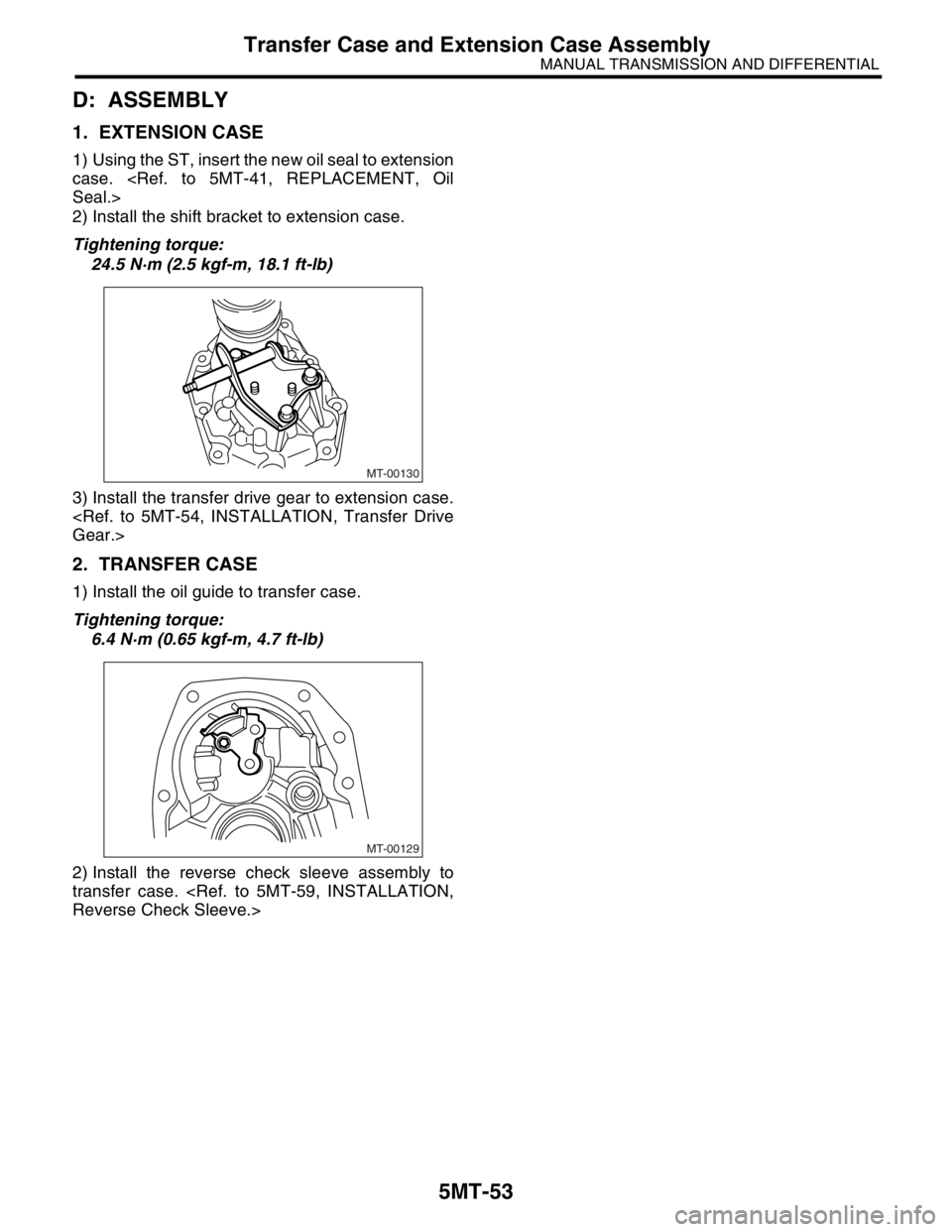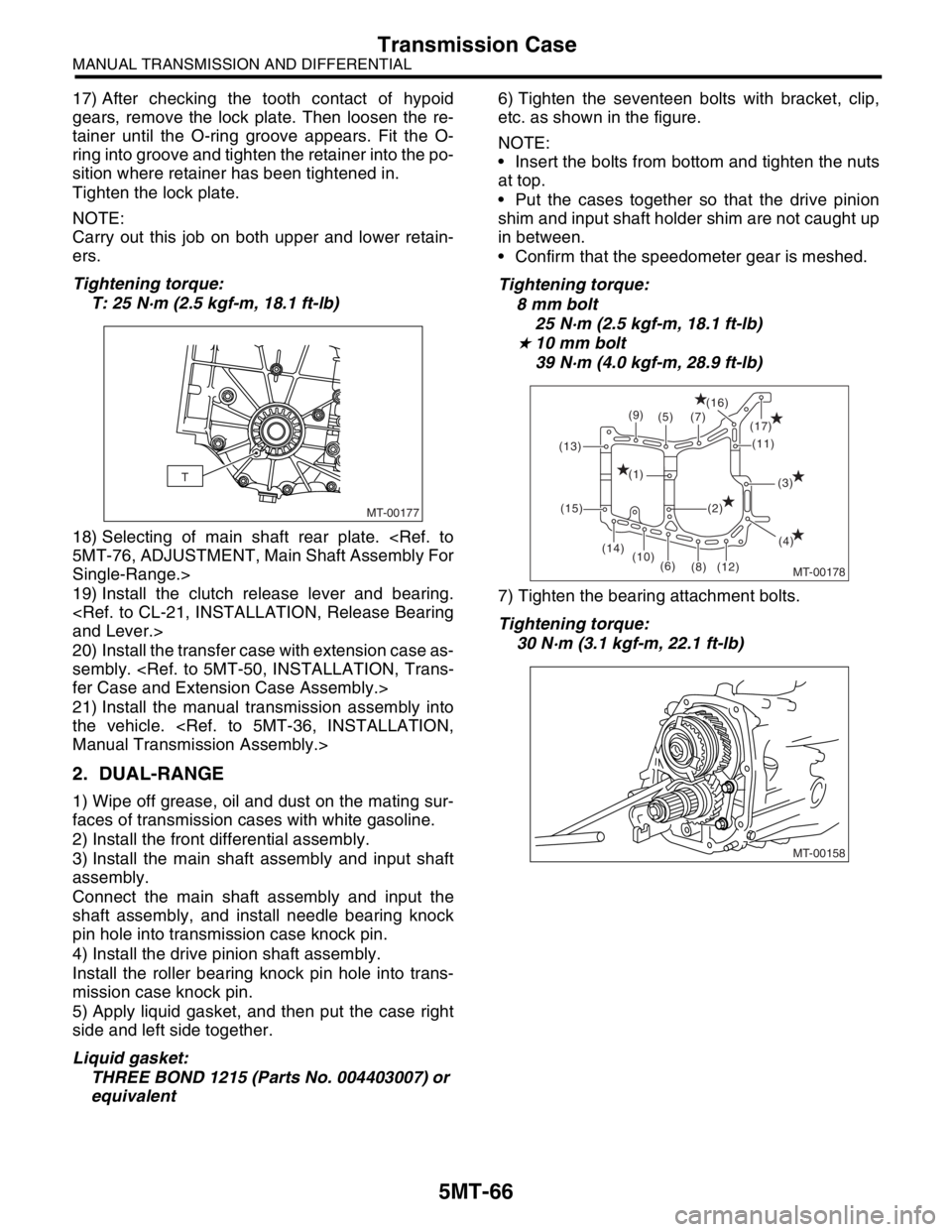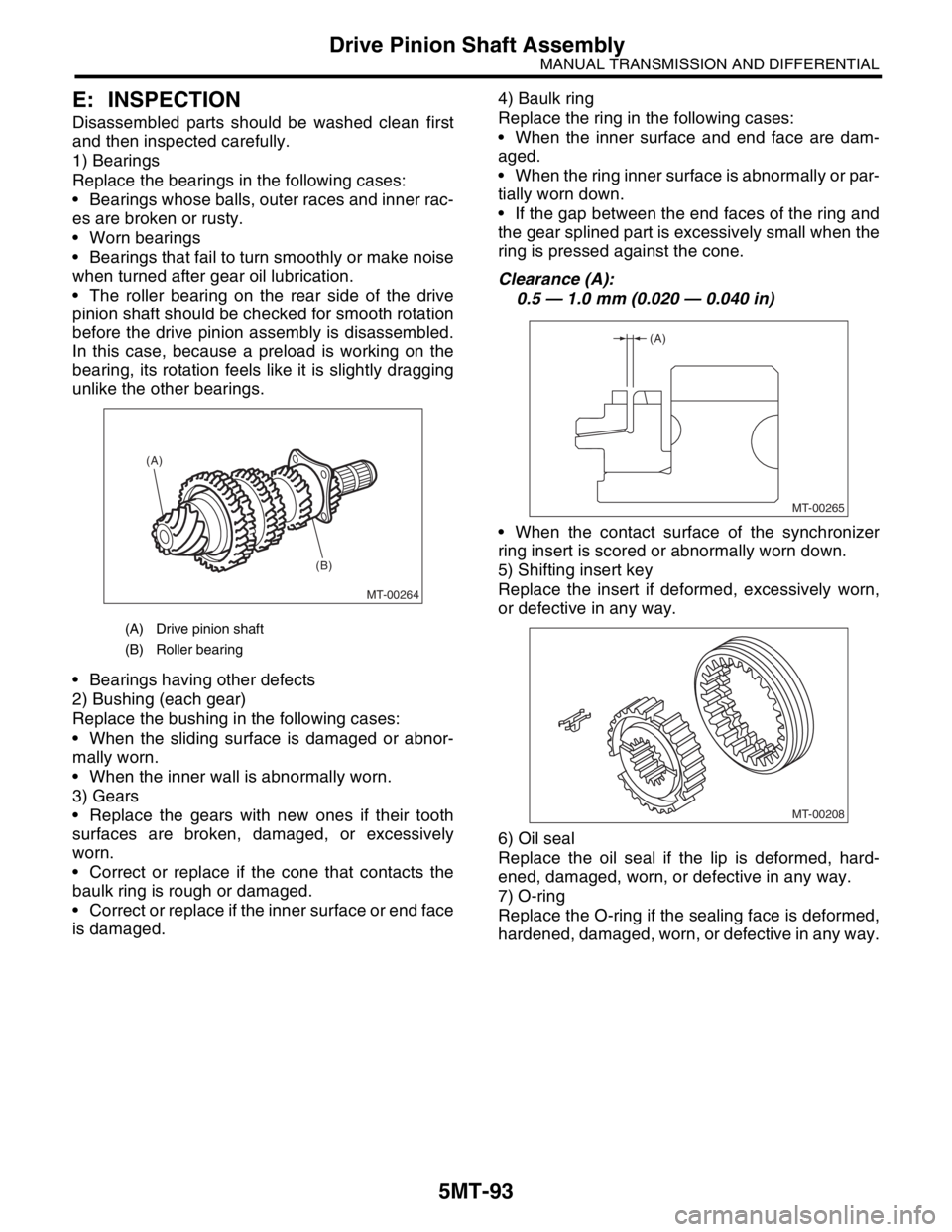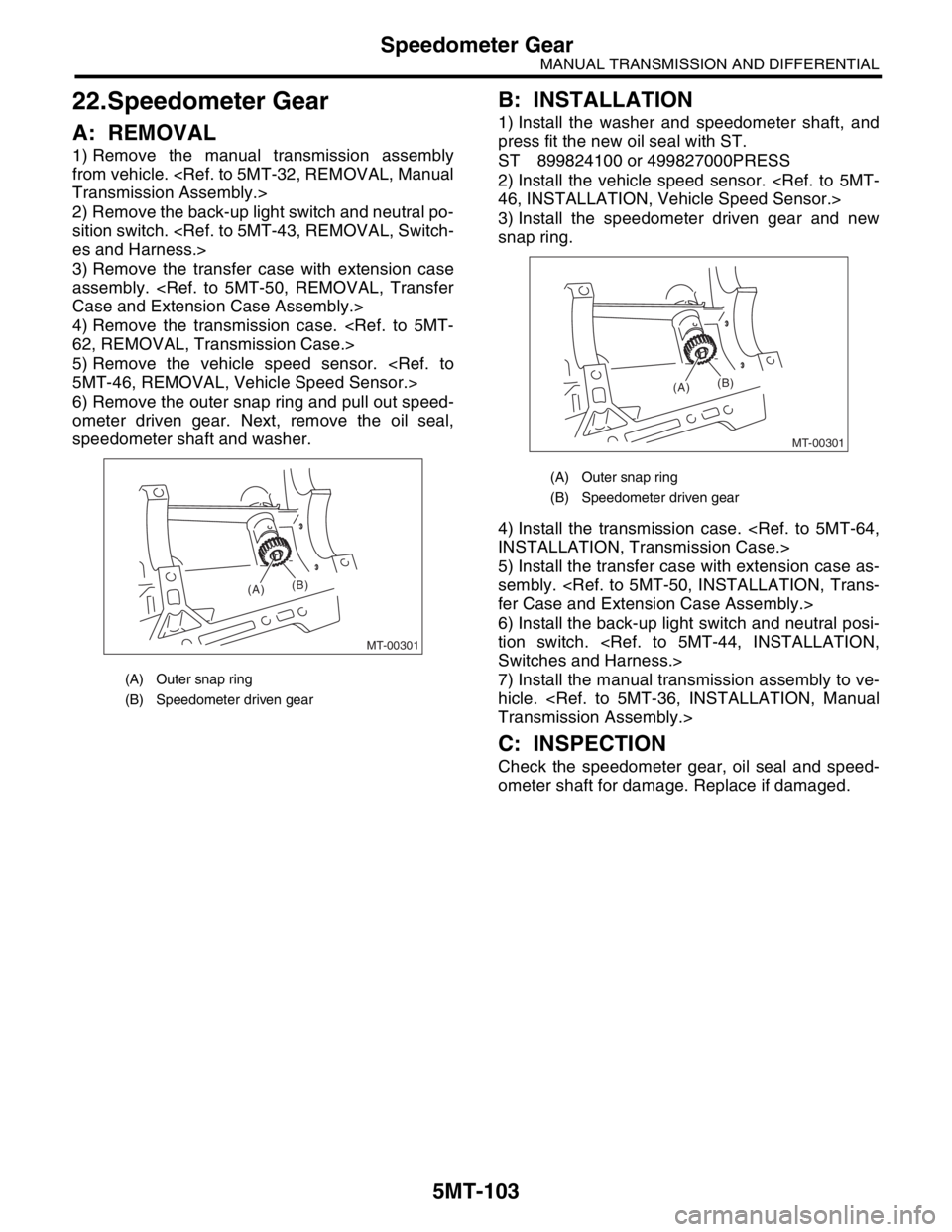2004 SUBARU FORESTER check oil
[x] Cancel search: check oilPage 2765 of 2870

5MT-53
MANUAL TRANSMISSION AND DIFFERENTIAL
Transfer Case and Extension Case Assembly
D: ASSEMBLY
1. EXTENSION CASE
1) Using the ST, insert the new oil seal to extension
case.
2) Install the shift bracket to extension case.
Tightening torque:
24.5 N·m (2.5 kgf-m, 18.1 ft-lb)
3) Install the transfer drive gear to extension case.
2. TRANSFER CASE
1) Install the oil guide to transfer case.
Tightening torque:
6.4 N·m (0.65 kgf-m, 4.7 ft-lb)
2) Install the reverse check sleeve assembly to
transfer case.
MT-00130
MT-00129
Page 2779 of 2870

5MT-66
MANUAL TRANSMISSION AND DIFFERENTIAL
Transmission Case
17) After checking the tooth contact of hypoid
gears, remove the lock plate. Then loosen the re-
tainer until the O-ring groove appears. Fit the O-
ring into groove and tighten the retainer into the po-
sition where retainer has been tightened in.
Tighten the lock plate.
NOTE:
Carry out this job on both upper and lower retain-
ers.
Tightening torque:
T: 25 N·m (2.5 kgf-m, 18.1 ft-lb)
18) Selecting of main shaft rear plate.
Single-Range.>
19) Install the clutch release lever and bearing.
20) Install the transfer case with extension case as-
sembly.
21) Install the manual transmission assembly into
the vehicle.
2. DUAL-RANGE
1) Wipe off grease, oil and dust on the mating sur-
faces of transmission cases with white gasoline.
2) Install the front differential assembly.
3) Install the main shaft assembly and input shaft
assembly.
Connect the main shaft assembly and input the
shaft assembly, and install needle bearing knock
pin hole into transmission case knock pin.
4) Install the drive pinion shaft assembly.
Install the roller bearing knock pin hole into trans-
mission case knock pin.
5) Apply liquid gasket, and then put the case right
side and left side together.
Liquid gasket:
THREE BOND 1215 (Parts No. 004403007) or
equivalent6) Tighten the seventeen bolts with bracket, clip,
etc. as shown in the figure.
NOTE:
Insert the bolts from bottom and tighten the nuts
at top.
Put the cases together so that the drive pinion
shim and input shaft holder shim are not caught up
in between.
Confirm that the speedometer gear is meshed.
Tightening torque:
8 mm bolt
25 N·m (2.5 kgf-m, 18.1 ft-lb)
★ 10 mm bolt
39 N·m (4.0 kgf-m, 28.9 ft-lb)
7) Tighten the bearing attachment bolts.
Tightening torque:
30 N·m (3.1 kgf-m, 22.1 ft-lb)
MT-00177
T
MT-00178
(9)
(7) (5)(16)
(17)
(11)
(3)
(4) (2) (1)
(12) (8) (6) (10) (14) (15) (13)
MT-00158
Page 2781 of 2870

5MT-68
MANUAL TRANSMISSION AND DIFFERENTIAL
Transmission Case
16) Turn the transmission main shaft several times
while tapping around the retainer lightly with plastic
hammer.
17) Inspect and adjust the backlash and tooth con-
tact of hypoid gear.
18) After checking the tooth contact of hypoid
gears, remove the lock plate. Then loosen the re-
tainer until the O-ring groove appears. Fit the O-
ring into groove and tighten the retainer into the po-
sition where retainer has been tightened in.
Tighten the lock plate.
NOTE:
Carry out this job on both upper and lower retain-
ers.
Tightening torque:
T: 24.5 N·m (2.5 kgf-m, 18.1 ft-lb)
19) Selection of main shaft rear plate
gle-Range.>
20) Install the transfer case with extension case as-
sembly.
21) Install the clutch release lever and bearing.
22) Install the manual transmission assembly into
the vehicle.
Check the transmission case for cracks, damage,
and oil leaks.
MT-00177
T
Page 2806 of 2870

5MT-93
MANUAL TRANSMISSION AND DIFFERENTIAL
Drive Pinion Shaft Assembly
E: INSPECTION
Disassembled parts should be washed clean first
and then inspected carefully.
1) Bearings
Replace the bearings in the following cases:
Bearings whose balls, outer races and inner rac-
es are broken or rusty.
Worn bearings
Bearings that fail to turn smoothly or make noise
when turned after gear oil lubrication.
The roller bearing on the rear side of the drive
pinion shaft should be checked for smooth rotation
before the drive pinion assembly is disassembled.
In this case, because a preload is working on the
bearing, its rotation feels like it is slightly dragging
unlike the other bearings.
Bearings having other defects
2) Bushing (each gear)
Replace the bushing in the following cases:
When the sliding surface is damaged or abnor-
mally worn.
When the inner wall is abnormally worn.
3) Gears
Replace the gears with new ones if their tooth
surfaces are broken, damaged, or excessively
worn.
Correct or replace if the cone that contacts the
baulk ring is rough or damaged.
Correct or replace if the inner surface or end face
is damaged.4) Baulk ring
Replace the ring in the following cases:
When the inner surface and end face are dam-
aged.
When the ring inner surface is abnormally or par-
tially worn down.
If the gap between the end faces of the ring and
the gear splined part is excessively small when the
ring is pressed against the cone.
Clearance (A):
0.5 — 1.0 mm (0.020 — 0.040 in)
When the contact surface of the synchronizer
ring insert is scored or abnormally worn down.
5) Shifting insert key
Replace the insert if deformed, excessively worn,
or defective in any way.
6) Oil seal
Replace the oil seal if the lip is deformed, hard-
ened, damaged, worn, or defective in any way.
7) O-ring
Replace the O-ring if the sealing face is deformed,
hardened, damaged, worn, or defective in any way.
(A) Drive pinion shaft
(B) Roller bearing
MT-00264
(A)
(B)
MT-00265
(A)
MT-00208
Page 2816 of 2870

5MT-103
MANUAL TRANSMISSION AND DIFFERENTIAL
Speedometer Gear
22.Speedometer Gear
A: REMOVAL
1) Remove the manual transmission assembly
from vehicle.
2) Remove the back-up light switch and neutral po-
sition switch.
3) Remove the transfer case with extension case
assembly.
4) Remove the transmission case.
5) Remove the vehicle speed sensor.
6) Remove the outer snap ring and pull out speed-
ometer driven gear. Next, remove the oil seal,
speedometer shaft and washer.
B: INSTALLATION
1) Install the washer and speedometer shaft, and
press fit the new oil seal with ST.
ST 899824100 or 499827000PRESS
2) Install the vehicle speed sensor.
3) Install the speedometer driven gear and new
snap ring.
4) Install the transmission case.
5) Install the transfer case with extension case as-
sembly.
6) Install the back-up light switch and neutral posi-
tion switch.
7) Install the manual transmission assembly to ve-
hicle.
C: INSPECTION
Check the speedometer gear, oil seal and speed-
ometer shaft for damage. Replace if damaged.
(A) Outer snap ring
(B) Speedometer driven gear
MT-00301
(A)(B)
(A) Outer snap ring
(B) Speedometer driven gear
MT-00301
(A)(B)
Page 2824 of 2870

5MT-111
MANUAL TRANSMISSION AND DIFFERENTIAL
General Diagnostic
26.General Diagnostic
A: INSPECTION
1. MANUAL TRANSMISSION
Symptom Possible cause Remedy
1. Gears are difficult to intermesh.
N
OTE:
The cause for difficulty in shifting gears
can be classified into two kinds: one is
malfunction of the gear shift system and
the other is malfunction of the transmis-
sion. However, if the operation is heavy
and engagement of the gears is difficult,
defective clutch disengagement may also
be responsible. Check whether the clutch
is correctly functioning, before checking
the gear shift system and transmission.(a) Worn, damaged or burred chamfer of
internal spline of sleeve and reverse
driven gearReplace.
(b) Worn, damaged or burred chamfer of
spline of gearsReplace.
(c) Worn or scratched bushings Replace.
(d) Incorrect contact between synchro-
nizer ring and gear cone or wear Correct or replace.
2. Gear slips out.
Gear slips out when coasting on rough
road.
Gear slips out during acceleration.(a) Defective pitching stopper adjustment Adjust.
(b) Loose engine mounting bolts Tighten or replace.
(c) Worn fork shifter, broken shifter fork
rail springReplace.
(d) Worn or damaged ball bearing Replace.
(e) Excessive clearance between splines
of synchronizer hub and synchronizer
sleeveReplace.
(f) Worn tooth step of synchronizer hub Replace.
(g) Worn 1st driven gear and driven shaft Replace.
(h) Worn 2nd driven gear and 2nd bush Replace.
(i) Worn reverse idler gear and bushing Replace.
3. Unusual noise comes from transmis-
sion.
N
OTE:
If an unusual noise is heard when the ve-
hicle is parked with its engine idling and if
the noise ceases when the clutch is disen-
gaged, it may be considered that the
noise comes from the transmission.(a) Insufficient or improper lubrication Lubricate or replace with specified oil.
(b) Worn or damaged gears and bearings
NOTE:
If the trouble is only wear of the tooth sur-
faces, merely a high roaring noise will oc-
cur at high speeds, but if any part is
broken, rhythmical knocking sound will be
heard even at low speeds.Replace.
Page 2825 of 2870

5MT-112
MANUAL TRANSMISSION AND DIFFERENTIAL
General Diagnostic
2. DIFFERENTIAL
Symptom Possible cause Remedy
1. Broken differential (case, gear, bear-
ing, etc.)
N
OTE:
Noise will develop and finally it will be-
come impossible to continue to run due to
broken pieces obstructing the gear revo-
lution. (a) Insufficient or improper oil Disassemble the differential and replace
broken components and at the same time
check other components for any trouble,
and replace if necessary.
(b) Use of vehicle under severe condi-
tions such as excessive load and
improper use of clutch Readjust the bearing preload and back-
lash and face contact of gears.
(c) Improper adjustment of taper roller
bearingAdjust.
(d) Improper adjustment of drive pinion
and hypoid driven gear Adjust.
(e) Excessive backlash due to worn dif-
ferential side gear, washer or differential
pinion vehicle under severe operating
conditions. Add recommended oil to specified level.
Do not use the vehicle under severe oper-
ating conditions.
(f) Loose hypoid driven gear clamping
boltsTighten.
2. Differential and hypoid gear noises
Troubles of the differential and hypoid
gear always appear as noise problems.
Therefore noise is the first indication of
the trouble. However noises from the
engine, muffler, tire, exhaust gas, bear-
ing, body, etc. are easily mistaken for the
differential noise. Pay special attention to
the hypoid gear noise because it is easily
confused with other gear noises. There
are the following four kinds of noises.
Gear noise when driving: If noise
increases as vehicle speed increases it
may be due to insufficient gear oil, incor-
rect gear engagement, damaged gears,
etc.
Gear noise when coasting: Damaged
gears due to maladjusted bearings and
incorrect shim adjustment
Bearing noise when driving or when
coasting: Cracked, broken or damaged
bearings
Noise which mainly occurs when turn-
ing: Unusual noise from differential side
gear, differential pinion, differential pinion
shaft, etc. (a) Insufficient oil Lubricate.
(b) Improper adjustment of hypoid driven
gear and drive pinionCheck tooth contact.
(c) Worn teeth of hypoid driven gear and
drive pinionReplace as a set.
Readjust the bearing preload.
(d) Loose roller bearing Readjust the hypoid driven gear to drive
pinion backlash and check tooth contact.
(e) Distorted hypoid driven gear or differ-
ential caseReplace.
(f) Worn washer and differential pinion
shaftReplace.
Page 2869 of 2870

CL-43
CLUTCH SYSTEM
General Diagnostic Table
2. CLUTCH PEDAL
3. DIAGNOSTIC DIAGRAM OF CLUTCH DRAG
4. Noisy clutch
Examine whether the noise is generated
when the clutch is disengaged, engaged,
or partially engaged.(a) Broken, worn or unlubricated release
bearingReplace the release bearing.
(b) Insufficient lubrication of pilot bearing Replace.
(c) Loose clutch disc hub Replace the clutch disc.
(d) Loose torsion spring retainer Replace the clutch disc.
(e) Deteriorated or broken torsion spring Replace the clutch disc.
5. Clutch grabs.
When starting the vehicle with the clutch
partially engaged, the clutch engages
suddenly and the vehicle jumps instead
of making a smooth start.(a) Grease or oil on facing Replace the clutch disc.
(b) Deteriorated cushioning spring Replace the clutch disc.
(c) Worn or rusted spline of clutch disc or
main shaftTake off rust, apply grease or replace the
clutch disc or main shaft.
(d) Deteriorated or broken torsion spring Replace the clutch disc.
(e) Loose engine mounting Retighten or replace the mounting.
(f) Deteriorated diaphragm spring Replace.
Trouble Corrective action
Insufficient pedal play Adjust pedal play.
Clutch pedal free play insufficient Adjust pedal free play.
Excessively worn and damaged pedal shaft and/or bushing Replace the bushing and/or shaft with a new one.
Step Check Yes No
1 CHECK GEAR NOISE.
1) Start the engine.
2) Disengage the clutch and shift quickly from
neutral to reverse in idling condition.Is there any abnormal noise
from the transmission gear?Go to step 2.Clutch is normal.
2 CHECK GEAR NOISE.
Disengage the clutch at idle and shift from neu-
tral to reverse within 0.5 — 1.0 seconds.Is there any abnormal noise
from the transmission gear?Go to step 3.Defective trans-
mission or exces-
sive clutch drag
torque. Inspect the
pilot bearing,
clutch disc, trans-
mission and clutch
disc hub spline.
3 CHECK GEAR NOISE.
1) Disengage the clutch at idle and shift from
neutral to reverse within 0.5 — 1.0 seconds.
2) With the clutch disengaged, shift from N to
R, R to N several times.Is there any abnormal noise
from the transmission gear?Defect in clutch
disengaging.
Inspect the clutch
disc, clutch cover,
clutch release, and
clutch pedal free
play.Clutch and fly-
wheel seizure.
Inspect the clutch
disc, spline of
clutch disc hub. Symptom Possible cause Corrective